- Home
- »
- Medical Devices
- »
-
In-vitro Fertilization Microscope Market Size Report, 2030GVR Report cover
![In-vitro Fertilization Microscope Market Size, Share & Trends Report]()
In-vitro Fertilization Microscope Market Size, Share & Trends Analysis Report By End-Use (Clinical, Academic Research), By Region, And Segment Forecast, 2024 - 2030
- Report ID: GVR-4-68039-327-3
- Number of Report Pages: 100
- Format: PDF, Horizon Databook
- Historical Range: 2018 - 2022
- Forecast Period: 2024 - 2030
- Industry: Healthcare
Market Size & Trends
The global in-vitro fertilization microscope market size was estimated at USD 109.78 million in 2023 and is projected to grow at a compound annual growth rate (CAGR) of 8.45% from 2024 to 2030. The market growth is attributed to factors such as improving success rates of in-vitro fertilization (IVF) procedures and the growing availability of financial assistance are expected to boost the market over the forecast period. Moreover, product innovations by manufacturers help in increasing treatment efficiency and reduce procedure costs, further propelling the adoption of novel technologies.
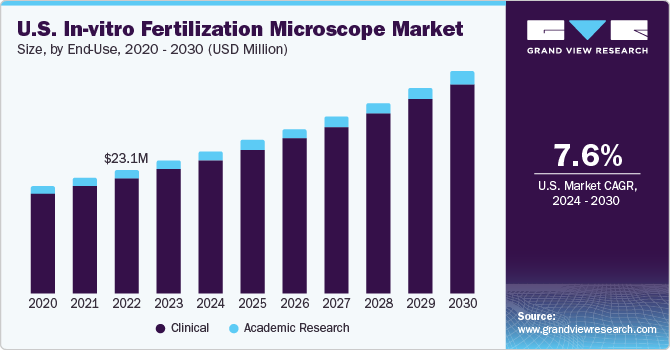
Over the past few years, there have been significant advancements in microscopes and microscope-related equipment used in IVF. Researchers have been focusing on developing innovations in AI, embryo assessment, and sperm selection to improve the process. For instance, in December 2022, researchers from Weill Cornell Medicine announced the development of STORK-A, an AI algorithm that can determine whether an in vitro-fertilized embryo has an abnormal or normal number of chromosomes. STORK-A has an accuracy rate of about 70% and uses microscope images of embryos captured five days after fertilization, a quality score assigned to the embryo by clinic staff, the mother's age, and other data typically gathered during the IVF process. This non-invasive method has the potential to significantly improve the success rates of IVF procedures and reduce the need for invasive testing.
Moreover, the increasing adoption of IVF microscopes is due to significant advancements in recent years, including innovations in high-contrast imaging techniques and related equipment. For instance, in 2019, annual data collected by the European Society of Human Reproduction and Embryology (ESHRE) revealed an increase in the adoption of IVF procedures and a corresponding increase in the success rate of these procedures. This trend is promoting initiatives focused on encouraging further innovations in IVF microscopes, which are important for ensuring continued improvements in the quality of microscopic examination in IVF applications.
Furthermore, the increasing adoption of IVF due to its success rate attracted private investors to this market, leading to a transition from a private practice/physician-owned business model to an investor-driven industry. This industrialization has shifted focus from IVF outcomes to revenue (commoditization). Although this resulted in initial growth due to activities such as the establishment of a chain of clinics, these centers witnessed a gradual decrease in the live birth rate.
Market Characteristics
The market growth stage is medium, and the pace is accelerating. The market is characterized by a high degree of innovation owing to the improved quality of microscopic examination in the IVF microscope-related equipment. The market is also characterized by a high level of merger and acquisition (M&A) activity by the leading players. This is due to several factors, including the adoption of advanced microscopy products in IVF clinics is expected to help reduce IVF costs for patients by reducing processing time and increasing efficiency.
For instance, in July 2022, Esco Lifesciences Group announced the acquisition of Evidence Solution, a software company providing IVF quality management systems & management technologies. The evidence witness system allows workflow scheduling, labeling, & traceability in IVF clinics to prevent errors in treatment.
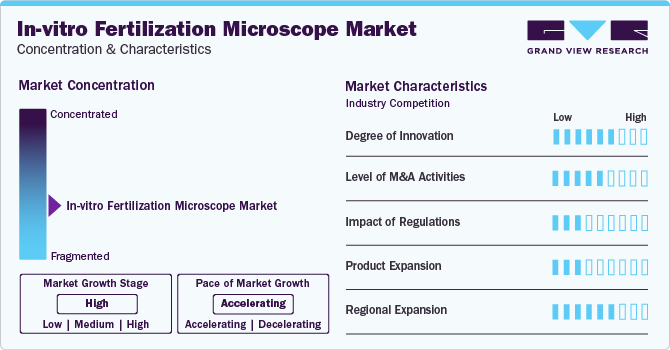
The market is also subject to increasing regulatory scrutiny. This is due to the increasing awareness about IVF services, developing nations have also taken measures to introduce regulations.The companies operating in the market must follow the guidelines established by agencies such as the American Society for Reproductive Medicine and the European Society of Human Reproduction and Embryology.
Regional concentration fuels the expansion of IVF microscopes, with focus on receiving investment from private investors for expansion of clinics. This strategic focus enhances the effectiveness of IVF microscopes tailored to specific geographic areas.
End-use Insights
Based on the end-use, the clinical segment led the market in 2023 with the largest revenue share of 94%. The growth of the segment is owing to the increased investments in facility expansion in various countries. For instance, in May 2021, Gulf Capital's ART Fertility Clinics, based in West Asia, and announced plans to invest USD 30 million in building 18 clinics in major Indian cities by 2023. Moreover, factors such as cost-effectiveness, availability of specialists, productive relationships with egg & sperm banks, and minimal risk of hospital-acquired infections are contributing to the growth of segment.
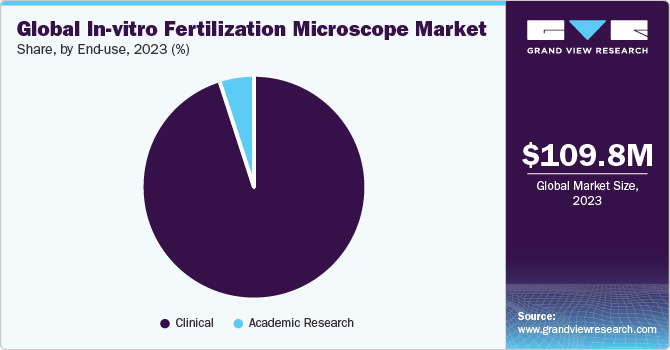
The IVF Clinics is projected to witness the fastest CAGR over the forecast period. The IVF clinics provide various services, such as assessing healthy eggs, analyzing semen, performing ICSI, monitoring embryos, and freezing and storing embryos. These clinics are introducing new and improved services, with support from private investors.
Regional Insights
Europe dominated the market with a revenue share of around 38% in 2023. Major factors contributing to the growth of this region include favorable regulatory changes and innovative technologies. The adoption of time-lapse technology with clinic-designed algorithms has been widespread, along with the development of microscopes that provide all imaging requirements in a single embryo chamber has helped reduce the cost & space requirements of the procedure. Moreover, recent revisions to laws, such as providing IVF access to the LGBTQ+ community, have positively impacted the market.
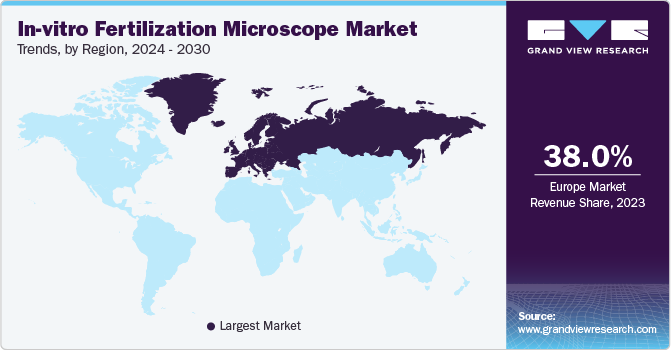
Asia Pacific is anticipated to witness significant CAGR over the forecast period. This growth is attributed to the presence of a large population and increasing awareness regarding IVF. Moreover, the demand for IVF treatments is expected to increase owing to the growth in fertility tourism, increase in the number of international companies trying to penetrate economically developing countries, and changes in the regulatory landscape in Asia Pacific. Furthermore, various initiatives are undertaken by key players to reduce the cost of products and focus on indigenous product manufacturing, which is expected to contribute to market growth.
Key Companies & Market Share Insights
Some of the key players operating in the market include Leica Microsystems, Olympus Corporation, Zeiss, and Nikon Corporation
-
Leica Microsystems has been a subsidiary of Danaher since 2005, under which it is a part of the life sciences and diagnostics segment. The company manufactures microscopes & scientific instruments and operates in three divisions: life sciences, medical, and industrial
-
Olympus Corporation operates via four segments: endoscopic solutions division, therapeutic solutions division, scientific solutions division, and imaging division. Its scientific solutions division offers measurement & imaging instruments, microscopes, videoscopes, and X-ray analyzers. The company has a presence in around 39 countries
Nikon Corporation, Euromex Microscopen BV, Sutter Instrument Company are some of the emerging market participants in the market.
-
Nikon Corporation manufactures optical instruments, such as optical glasses, imaging products, healthcare products, and industrial metrology products. The company operates via four segments—industrial metrology, healthcare, precision equipment, and imaging products. The microscope solutions unit is part of its healthcare business division
-
Sutter Instrument Company is a manufacturer of instruments used in research. The company’s product portfolio includes imaging products, microscopes, amplifiers, micromanipulators, stages & translators, and perfusion systems. The company supplies products globally through its network of distributors in around 49 countries across North America, Latin America, Europe, Asia, Australia/New Zealand, and the Middle East
Key In-vitro Fertilization Microscope Companies:
- Linkam Scientific Instruments
- Olympus Corporation
- Leica Microsystem (Danaher Corporation)
- Meiji Techno
- Zeiss
- Euromex Microscopen B.V.
- Labomed, Inc.
- Nikon Corporation
- Narishige Group
- Eppendorf AG
- Hamilton Thorne Ltd.
- Sutter Instrument Company
- Tritech Research, Inc.
Recent Developments
-
In October 2023 , Hamilton Thorne Ltd. acquired Gynetics Medical Products and Gynetics Services. This acquisition helped Hamilton Thorne expand its expertise, manufacturing capabilities, and product offerings in consumables, specifically in the rapidly growing European IVF market.
-
In December 2022 , Hamilton Thorne Ltd. acquired Microptic, S.L, a leading developer of Computer-Assisted Semen Analysis (CASA) software, consumables, and image analysis systems that incorporate AI. This acquisition strengthened Hamilton Thorne's position in the CASA market for IVF clinics.
In-vitro Fertilization Microscope Market Report Scope
Report Attribute
Details
Market size value in 2024
USD 118.78 million
Revenue forecast in 2030
USD 193.25 million
Growth rate
CAGR of 8.45% from 2024 to 2030
Base year for estimation
2023
Historical data
2018 - 2022
Forecast period
2024 - 2030
Quantitative units
Revenue in USD million/billion and CAGR from 2024 to 2030
Report updated
January 2024
Report coverage
Revenue forecast, company ranking, competitive landscape, growth factors, and trends
Segments covered
End-use, region
Country scope
U.S.; Canada; Germany; UK; Spain; France; Italy; Sweden; Norway; Denmark; Japan; China; India; Australia; Thailand; South Korea; Brazil; Mexico; Argentina; South Africa; UAE; Saudi Arabia and Kuwait
Key companies profiled
Linkam Scientific Instruments; Olympus Corporation; Leica Microsystems; Meiji Techno; ZEISS; Euromex Microscopen BV; Labomed, Inc.; Nikon Corporation; Narishige Group; Eppendorf; Hamilton Thorne Ltd; Sutter Instrument Company; Tritech Research, Inc
Customization scope
Free Free report customization (equivalent up to 8 analysts working days) with purchase. Addition or alteration to country, regional & segment scope.
Pricing and purchase options
Avail customized purchase options to meet your exact research needs. Explore purchase options
Global In-vitro Fertilization Microscope Market Report Segmentation
This report forecasts revenue growth at regional and country levels and provides an analysis of the latest industry trends in each of the sub-segments from 2018 to 2030. For this report, Grand View Research has segmented the in-vitro fertilization microscope market based on end-use, and region:
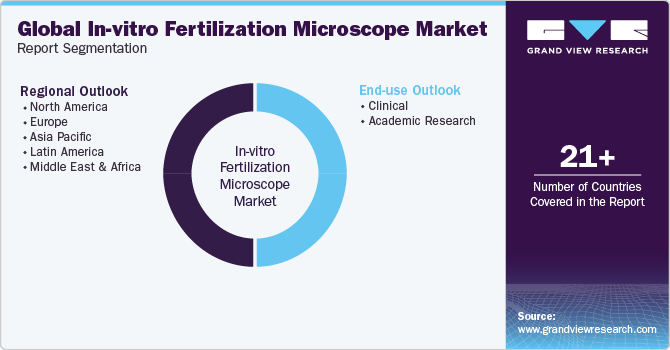
-
End-use Outlook (Revenue, USD Million, 2018 - 2030)
-
Clinical
-
Academic Research
-
-
Regional Outlook (Revenue, USD Million, 2018 - 2030)
-
North America
-
U.S.
-
Canada
-
-
Europe
-
UK
-
Germany
-
France
-
Italy
-
Spain
-
Sweden
-
Norway
-
Denmark
-
-
Asia Pacific
-
Japan
-
China
-
India
-
Australia
-
Thailand
-
South Korea
-
-
Latin America
-
Brazil
-
Mexico
-
Argentina
-
-
MEA
-
South Africa
-
Saudi Arabia
-
UAE
-
Kuwait
-
-
Frequently Asked Questions About This Report
b. Key factors that are driving the market growth include increasing adoption of the IVF microscopes due to improving success rates and due to the technological advancements.
b. The global in-vitro fertilization microscopes market size was estimated at USD 109.78 million in 2023 and is expected to reach USD 118.78 million in 2024.
b. The global in-vitro fertilization microscopes market is expected to grow at a compound annual growth rate of 8.45% from 2024 to 2030 to reach USD 193.25 million by 2030.
b. Europe dominated the IVF microscopes market with a share of around 38.31% in 2023. This is attributable to growing fertility tourism, legal reforms, and product innovation.
b. Some key players operating in the IVF microscopes market include LINKAM SCIENTIFIC INSTRUMENTS, Olympus Corporation, Leica Microsystems, Meiji Techno, Zeiss, Euromex Microscopen B.V., Labomed, Nikon Corporation, Narishige Group, Eppendorf, Hamilton Thorne Ltd., Sutter Instrument Company, Tritech Research, Inc.
Share this report with your colleague or friend.
![gvr icn]()
NEED A CUSTOM REPORT?
We can customize every report - free of charge - including purchasing stand-alone sections or country-level reports, as well as offer affordable discounts for start-ups & universities. Contact us now
![Certified Icon]()
We are GDPR and CCPA compliant! Your transaction & personal information is safe and secure. For more details, please read our privacy policy.
We are committed towards customer satisfaction, and quality service.
"The quality of research they have done for us has been excellent."





